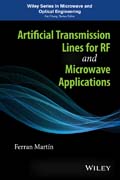
This book presents and discusses alternatives to ordinary transmission lines for the design and implementation of advanced RF/microwave components in planar technology.This book is devoted to the analysis, study and applications of artificial transmission lines mostly implemented by means of a host line conveniently modified (e.g., with modulation of transverse dimensions, with etched patterns in the metallic layers, etc.) or with reactive loading, in order to achieve novel device functionalities, superior performance, and/or reduced size. The author begins with an introductory chapter dedicated to the fundamentals of planar transmission lines. Chapter 2 is focused on artificial transmission lines based on periodic structures (including non–uniform transmission lines and reactively–loaded lines), and provides a comprehensive analysis of the coupled mode theory. Chapters 3 and 4 are dedicated to artificial transmission lines inspired by metamaterials, or based on metamaterial concepts. These chapters include the main practical implementations of such lines and their circuit models, and a wide overview of their RF/microwave applications (including passive and active circuits and antennas). Chapter 5 focuses on reconfigurable devices based on tunable artificial lines, and on non–linear transmission lines. The chapter also introduces several materials and components to achieve tuning, including diode varactors, RF–MEMS, ferroelectrics, and liquid crystals. Finally, Chapter 6 covers other advanced transmission lines and wave guiding structures, such as electroinductive–/magnetoinductive–wave lines, common–mode suppressed balanced lines, lattice–network artificial lines, and substrate integrated waveguides.Artificial Transmission Lines for RF and Microwave Applications provides an in–depth analysis and discussion of artificial transmission lines, including design guidelines that can be useful to researchers, engineers and students. INDICE: PrefaceAcknowledgments1. Fundamentals of Planar Transmission Lines1.1 Planar transmission lines, distributed circuits and artificial transmission lines1.2 Distributed circuit analysis and main transmission line parameters1.3 Loaded (terminated) transmission lines1.4 Lossy transmission lines1.5 Comparative analysis of planar transmission lines1.6 Some illustrative applications of planar transmission linesReferences2. Artificial Transmission Lines based on Periodic Structures2.1 Introduction and scope2.2 Floquet analysis of periodic structures2.3 The transfer matrix method2.4 Coupled mode theory2.5 ApplicationsReferences3. Metamaterial Transmission Lines: Fundamentals, Theory, Circuit Models, and Main Implementations 3.1 Introduction, terminology, and scope3.2 Effective medium metamaterials3.3 Electrically small resonators for metamaterials and microwave circuit design3.4 Canonical models of metamaterial transmission lines3.5 Implementation of metamaterial transmission lines and lumped element equivalent circuit modelsReferences4. Metamaterial Transmission Lines: RF/Microwave Applications4.1 Introduction4.2 Applications of CRLH transmission lines4.3 Transmission lines with metamaterial loading and applicationsReferences5. Reconfigurable, Tunable and Nonlinear Artificial Transmission Lines5.1 Introduction5.2 Materials, components and technologies to implement tunable devices5.3 Tunable and reconfigurable metamaterial transmission lines and applications5.4 Nonlinear transmission lines (NLTLs)References6. Other Advanced Transmission Lines6.1 Introduction6.2 Magnetoinductive–wave (MIW) and electroinductive–wave (EIW) delay lines6.3 Balanced transmission lines with common–mode suppression6.4 Wideband artificial transmission lines6.5 Substrate integrated waveguides (SIW) and their application to metamaterial transmission linesReferencesAppendixesAppendix A. Equivalence between plane wave propagation in source–free, linear, isotropic and homogeneous media, TEM wave propagation in transmission lines and wave propagation in transmission lines described by its distributed circuit modelAppendix B. The Smith ChartAppendix C. The scattering matrixAppendix D. Current density distribution in a conductorAppendix E. Derivation of the simplified coupled mode equations and coupling coefficient from the distributed circuit model of a transmission lineAppendix F. Averaging the effective dielectric constant in EBG–based transmission linesAppendix G. Parameter extractionG.1 Parameter extraction in CSRR–loaded linesG.2 Parameter extraction in SRR–loaded linesG.3 Parameter extraction in OSRR–loaded linesG.4 Parameter extraction in OCSRR–loaded linesAppendix H. Synthesis of resonant type metamaterial transmission lines by means of Aggressive Space Mapping (ASM)H.1 General formulation of ASMH.2 Determination of the convergence region in the coarse model spaceH.3 Determination of the initial layoutH.4 The core ASM algorithmH.5 Illustrative examples and convergence speedAppendix I. Conditions to obtain all–pass X–type and bridged–T networksIndex
- ISBN: 978-1-118-48760-0
- Editorial: Wiley–Blackwell
- Encuadernacion: Cartoné
- Páginas: 528
- Fecha Publicación: 27/07/2015
- Nº Volúmenes: 1
- Idioma: Inglés
